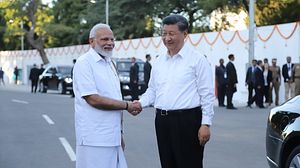In his assessment of the ongoing India-China border standoff, the venerable Ashley Tellis said that India has three options ahead of it: one, give in to China’s border demands; two, physically push the Chinese out and risk a war; or three – his recommendation – play “tit for tat.”
Tellis pointed out that there are locations along the Line of Actual Control (LAC) – the de facto border between the two countries – where India has a relative advantage over the Chinese. The Indian army should ensconce itself in these places, Tellis said, in order to force Beijing to negotiate.
The situation on the ground is unclear and confusing, but some reports have suggested that India is trying to do precisely this. Border standoffs between India and China ebb and flow regularly and Beijing has often been seen as the more powerful of the two. Over the past many years, India has tried to compete by making significant progress in developing its own border infrastructure. Some analysts have suggested that this was, in fact, how the latest standoff began: India has laid a series of roads and air strips along the border and the Chinese are now seeking to counter that threat.
Yet, despite these developments, if India is to successfully build chips for retaliation, it would have to work outside the region itself.
Much like the conflict with Pakistan, Chinese aggression now keeps India tangled up in South Asia, diverting away its focus and attention from foreign policy opportunities in other parts of the world. Meanwhile, China is expanding its footprint and influence globally: The Belt and Road Initiative (BRI) has captured eyeballs across the world. The Asian Infrastructure Investment Bank (AIIB) has pulled together countries across all levels of development. Even at the UN, Chinese influence is steeply on the rise.
The trouble for India is that it has many significant disadvantages in South Asia relative to Beijing. China decidedly holds the psychological advantage in the Himalayas, if nothing else. In 1962, India lost heavily to China in the only war between the two countries – and it was arguably the most significant foreign policy event in India’s independent history. Prime Minister Jawaharlal Nehru was punching far and wide before the war – leading UN efforts in the Congo and mediating disputes in Korea. In the years that followed the war, Nehru’s global outlook was junked. His daughter Indira Gandhi began a phase of introversion – she retired from the global stage and sought instead to build India’s material capacity. Her foreign policy was largely limited to the immediate neighborhood.
Chinese aggression continues to exploit India’s weaknesses today. These standoffs have very negative implications for Indian foreign policy in South Asia: They stoke paranoia in New Delhi and sabotage India’s interests, from Nepal and Bhutan, to Sri Lanka and the Maldives. Just this month, for instance, as India and Nepal quibbled over a roadway in Kalapani, the Indian Army chief insinuated that Kathmandu was being influenced by the Chinese. That comment was received just as well as one would expect, with many Nepalese commentators complaining that their sovereignty had been insulted. In 2017, the Doklam standoff similarly sullied India’s relations with Bhutan.
India’s only credible counter to Chinese power in the Himalayas would be to assume a more global role of its own – and build chips for retaliation elsewhere. And there are many opportunities all over the world: With America taunting its own allies and withdrawing from international institutions under President Trump, some countries are seeking leadership from other quarters to counter-balance Chinese influence. In Asia and Africa, debt-traps induced by the BRI are gradually stoking discontent. If India focuses on leveraging its advantages as a development partner, particularly in the post-COVID-19 era, it can use its newfound influence as a bargaining chip against Chinese interests in these countries.
Then, there is Southeast Asia, where countries are similarly pushing back against Chinese aggression in the South China Sea. This week, for instance, Indonesia rejected Chinese claims yet again, saying that it contravenes international law. This is a more ready opportunity for India: As policy analyst Nitin Pai pointed out, India should “shift the conflict away from our Himalayan boundaries to … the South China Sea and the Indian Ocean.” In addition to strengthening defence partnerships with countries in the region, Pai said that India should “immediately increase naval operations east of the Malacca Straits and follow up with a rapid tri-service expeditionary capability in the Indian Ocean Region.”
China has significant advantages in keeping India preoccupied through periodic standoffs in the Himalayas; this is a region where all odds are in Beijing’s favor. If New Delhi wants to heed Tellis’ advice of retaliation, it should avoid exhausting all its resources and energy in South Asia – and go global instead.

































